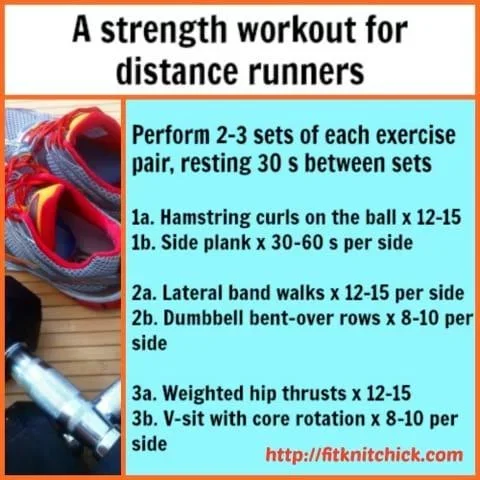Runners, reduce your risk of injury via strength training
Many of my personal trainer clients are distance runners. Most have had to deal with an injury at one point or other. Injuries that kept them from their primary fitness activity and cause them considerable psychological angst to boot.
The majority of the injuries they report can be traced back to one of the following:
- forward leaning postures; while many of us suffer from postural deviations caused by sitting too much, endurance running can exacerbate the problem if the runner leans forward while running
- anterior-posterior muscular imbalances; front of the body (anterior) muscles become stronger than back of the body (posterior) muscles leading to lower back pain, tight joints and poor posture
- too much of the same thing; repetitive stress injuries frequently occur once a particular ‘threshold distance’ is reached. These injuries can be difficult to rehab without taking a complete break from running, something that most endurance athletes find difficult to bear
- weak lateral movement patterns; side to side and rotational movements aren’t properly trained by running, thereby compromising agility, core strength and increasing the potential for knee and ankle injuries
- ‘too much too soon’; increasing mileage before the muscles, tendons and ligaments of the hips, knees and ankles are strong enough and have sufficient stability to go the distance
Muscle groups for runners to focus on
When designing weight training programs for my runner-clients, I tend to focus on strengthening the muscle groups most likely to rectify the above problems. Frequently, that means training the following:
- hamstrings and gluteus maximus; due to constant forward motion, runners are often ‘quad-dominant’, that is the quadriceps (anterior) are much stronger than the hamstrings and glutes (posterior)
- obliques and erector spinae; improving core strength not only reduces the likelihood of lower back and hip pain, it also improves athletic performance by making proper running posture easier to maintain. In most runners, the obliques and erector spinae (lower back) are the weakest link in the core-chain.
- gluteus medius and adductors; strengthening weak medial glutes and inner thigh muscles can help improve knee tracking, thereby reducing the likelihood of a variety of knee injuries as well as ITB syndrome (here are some ideas for working out with a knee injury)
- posterior deltoids, trapezius, rhomboids, latissimus dorsi; strengthening the muscles of the upper back can improve posture and running form
The best strength exercises for distance runners:
Below are a list of the exercises I recommend for strengthening the weak muscle groups exhibited by many distance runners.
If you’ve ever suffered a running injury before, you’ll notice that many of the exercises I suggest are the same ones you recommended by your physiotherapist or primary care physician. I’d much rather my clients practice ‘pre-hab’ than have to go to ‘re-hab’!
Click through the links to see demonstrations of proper exercise form and suggestions for progression.
Hamstrings and gluteus maximus:
- Hip thrusts (with single leg only)
- Hamstring curls on the ball (start with both feet on the ball)
Obliques and erector spinae:
- Bird dog
- Side planks (with optional rotation)
- V-sit with core rotation (start with both feet on the ground)
Gluteus medius and adductors:
- Lateral band walk
- Lateral lunges (with optional reach)
Back of the shoulder and upper back:
- Bent over rows (using a band or dumbbells)
- YTWL (using a bench or a stability ball)
A sample strength training workout for distance runners
Distance runners often lament that their training schedule keeps them so busy that don’t have time for extra workouts. The following strength training workout shouldn’t take any longer than 20 minutes. Try fitting it in twice a week, after one of your shorter runs. Because your muscles will already be warm, there’s no need to take extra time for a warm-up or mobilization work.
Treat each pair of exercises as a ‘super-set’; perform all the repetitions of exercise ‘a’ followed immediately by all the repetitions of exercise ‘b’. Rest for 30 seconds and repeat a second time. (Progress this workout by adding a third set after you’ve been doing it for several weeks).
Do the same with the 2nd and 3rd pair of exercises. Finish with a stretch.
Don’t believe me? Believe a fellow runner
I have run regularly for 5 years. I have made weight training a regular part of my regime for the last 6 months or so. I have noticed increased speed, less fatigue and fewer little injuries… Bonnie S.
Building your muscles is key to running not just for during the run. I find it also helps recovery. Especially strengthening my core muscles not just the leg muscles…. Sylvia B.
Strength training for me means faster recovery time from my runs and protection of my joints from the running impact… Danea A.
...weight training really helps with recovery, injury prevention and strengthening the muscles that you need/use as a runner including core, glutes, legs. Especially as I’ve gotten older, I’ve learned that a well-balanced workout program makes me a stronger and better runner and that definitely includes weight training… Jennifer Y.
Bio:
Tamara Grand is a BCRPA-Certified Personal Trainer, Advanced Group Fitness Leader and author of the popular fitness and health blog fitknitchick.com. Holding a PhD in Biology, she’s uniquely capable of translating the latest exercise science research into language her clients, class participants and readers can understand.
Tamara’s particularly passionate about encouraging women of all ages to strength train for form, function and fun and leads an online training program to help 40+ women combat midlife weight gain and muscle loss. Check out her recently released fitness book, Ultimate Booty Workouts, a 12-week progressive resistance training program for getting the legs, glutes and core you’ve always wanted.
Find her on Instagram and Twitter: @fitknitchick_1
Other Treadmill Reviews:
- Test HomePage
- NordicTrack Commercial X14i
- Echelon Stride
- NordicTrack C 590 Pro
- NordicTrack T 7.5 S - Pros & Cons (2024)
- Sole TD80 Treadmill Desk
- NordicTrack Commercial X11i
- NordicTrack T 8.5 S - Pros & Cons (2024)
- Horizon Elite T5
- Exerpeutic TF1000
- NordicTrack T 6.5 S - Pros & Cons (2024)
- ProForm Sport 5.0
- ProForm Premier 900
- ProForm ZT6
- NordicTrack FreeStride Trainer FS5i (Discontinued)
- Bowflex Max Trainer M5
- BowFlex TreadClimber TC100
- ProForm Power 795
- ProForm Sport 7.0
- NordicTrack Incline Trainer X15i
- NordicTrack C 1650 Treadmill
- Horizon Elite T9
- Official Boston Marathon Treadmill 4.0
- NordicTrack Treadmill Desk
- NordicTrack C 1630 Pro
- NordicTrack C 970 PRO
- Bowflex TC20 TreadClimber



